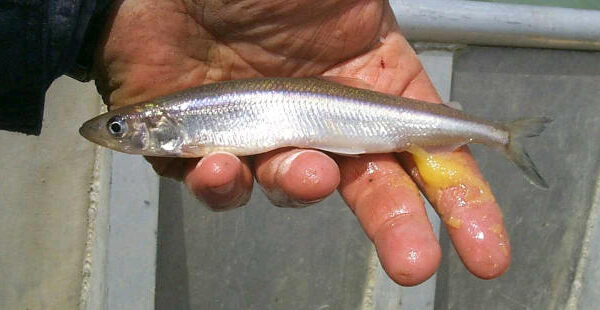Rainbow Smelt

Species at a Glance
The rainbow smelt (Osmerus mordax) is a small, predatory fish popular with anglers because of its fine flavor. Its Latin name, Osmerus, which comes from the Greek word meaning “odor” is fitting because when removed from the water, it gives off an odor which smells like freshly cut cucumbers.
Species Description
The rainbow smelt has a small, slender body that typically ranges from 7-9 in (18-23 cm) in length, and weighs around 3 oz (85 g). It is mostly silver, with pale olive-green back and iridescent purple, blue and pink sides. In the water, the rainbow smelt appears to shimmer colorfully, but when removed, the color appears as a dull silver white. The head is elongated, with a relatively large mouth and a pointed snout. The lower jaw protrudes and prominent teeth can be seen on the tongue and both jaws. Scales are thin and easily detached. Spawning males are covered on the head, body, and fins with tiny bumps called nuptial tubercles. The rainbow smelt can be distinguished from many look-a-like minnow species by its conspicuous teeth and an adipose fin that is lacking in minnows.
Native & Introduced Ranges
Native to the Atlantic and Pacific Coastal drainages of North America and the Pacific drainages of Asia, the rainbow smelt was introduced into Michigan’s Crystal Lake as a food source for stocked salmon in 1912. It soon escaped into Lake Michigan, and spread quickly throughout the Great Lakes, the Mississippi River, and other inland waters. This species has done so well in the Great Lakes that a commercial fishery targeting smelts has been operating for many years. In Pennsylvania, rainbow smelt are established in Lake Erie and Presque Isle Bay in Erie County, Keystone Lake in Armstrong County, Raystown Lake in Huntingdon County, the Shenango River in Mercer County, and Harvey’s Lake in Luzerne County.
Biology & Spread
This species can spread quickly through natural waterway connections, but its movement to new waterways can also be facilitated by both intentional and unintentional human transfer. Potential vectors include ballast water, bait bucket transfers, improper disposal of fish remains, and intentional introduction as forage and bait fish.
Habitat
The rainbow smelt is anadromous, which means it can move from saltwater to freshwater to reproduce, but it can also live completely in reshwater. While it typically prefers deep, cool, unproductive lakes, it can inhabit a wide range of lake types and is often found in shallower coastal areas for feeding as winter approaches. When spawning, the rainbow smelt typically moves into streams or closer to shorelines.
Impacts
By competing with other fish for food, and feeding on the young of native species, the rainbow smelt can have had a serious impact on native species that eat plankton and other fish. The rainbow smelt feeds on zooplankton, benthic crustaceans, and the young of other fish. These feeding habits may disrupt food webs and impact the base of the food chain. It also directly competes with sport fish such as perch, walleye, lake herring, and lake trout for food, and has caused documented declines in populations of cisco, blue pike, herring and other imperiled species in regions where it has been introduced. Smelt introductions also correspond with increased levels of pollutants such as mercury and PCBs in fish.
Prevention & Control
Populations of rainbow smelt may be controlled through the use of rotenone, intentional overfishing, increasing predator abundance, or a combination of these approaches. However, once established, rainbow smelt can be very difficult and costly to control and most solutions are only temporary.
- The best way to manage rainbow smelt is to prevent its spread and introduction into new areas.
- Learn to identify the rainbow smelt.
- Always eliminate water from all equipment and remove any visible mud and plants before leaving a water body and transporting to new locations.
- Clean gear and equipment with either hot water (104° F or 40° C), or salt water OR let dry thoroughly for at least five days before entering a new water body.
- Empty bait buckets on land or in the trash, never dump live bait into the water.
References:
Bennet, J. Rainbow Smelt (Osmerus mordax). Illinois-Indiana Sea Grant Program.
http://www.iisgcp.org/exoticsp/Rainbow_Smelt.htm
Fuller, P., E. Maynard, J. Larson, A. Fusaro, T.H. Makled, and M. Neilson, 2019, Osmerus mordax (Mitchill,
1814): U.S. Geological Survey, Nonindigenous Aquatic Species Database, Gainesville, FL,
Gunderson, Jeff. 2008. Rainbow Smelt (Osmerus mordax). Minnesota Sea Grant Program.
Mercado-Silva, N., Olden, J.D., Maxted, J. T., Hrabik, T.R., and Vander Zanden, J.M. 2006. Forecasting the
Spread of Invasive Rainbow Smelt in the Laurentian Great Lakes Region of North America.
Conservation Biology. 20(6): 1740-1749.



